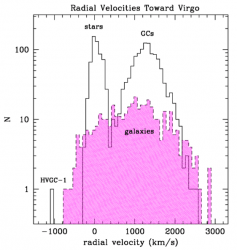We’ve discovered dozens of so-called “hypervelocity stars” — single stars that break the stellar speed limit. But today astronomers multiplied the number of these ‘runaway’ stars by hundreds of thousands. The Virgo Cluster galaxy, M87, has ejected an entire star cluster, throwing it toward us at more than two million miles per hour.
“Astronomers have found runaway stars before, but this is the first time we’ve found a runaway star cluster,” said lead author Nelson Caldwell of the Harvard-Smithsonian Center for Astrophysics, in a press release.
About one in a billion stars travel at a speed roughly three times greater than our Sun (which clocks in at 220 km/s with respect to the galactic center). At a speed that fast, these stars can easily escape the galaxy entirely, traveling rapidly throughout intergalactic space.
But this is the first time an entire star cluster has broken free.
What would cause an entire cluster — hundreds of thousands of stars packed together a million times more closely than in the neighborhood of our Sun — to reach such a tremendous speed?
Single hypervelocity stars have puzzled astronomers for years. But by observing their speed and direction, astronomers can trace these stars backward, finding that some began moving quickly in the Galactic Center. Here, an interaction with the supermassive black hole can kick a star away at an alarming speed. Another option is that a supernova explosion propelled a nearby star to a huge speed.
Caldwell and colleagues think M87 might have two supermassive black holes at its center. The star cluster wandered too close to the pair, which picked off many of the cluster’s outer stars while the inner core remained intact. The black holes then acted like a slingshot, flinging the cluster away at a tremendous speed.
The star cluster is moving so fast it should soon by sailing into intergalactic space. It may already be, but its distance remains unknown.

Image Credit: Caldwell et al.
The team found the globular cluster — dubbed HVGC-1 — with a stroke of luck. They had been analyzing 2,500 globular cluster candidates for years. While a computer algorithm automatically calculated the speed of every cluster, any oddity was analyzed by hand.
Over 1,000 candidates have measured velocities between 500 and 3000 km/s. These speeds are typical for Virgo Cluster members. But HVGC-1 has a radial velocity of -1026 km/s. “This is the most negative, bulk velocity ever measured for an astronomical object not orbiting another object,” writes Caldwell.
“We didn’t expect to find anything moving that fast,” said coauthor Jay Strader of Michigan State University.
Future measurements pinpointing the exact distance to the globular cluster will help shed light on its exact origins.
The paper will be published in The Astrophysics Journal Letters and is available for download here.


A gravitational slingshot works by gaining the orbital velocity of a planet around the Sun, or in this case of one a pair of black holes orbiting their common barycenter.
The spacecraft or star cluster leaves the object conferring the orbital boost at exactly the same trajectory speed it approached, as is required by conservation of energy, but it can gain a speed enhancement (or loss) relative to the barycenter of the system, in this case the center of the galaxy. (This is an example of Galilean relativism.)
There’s no requirement for the star system to lose mass to achieve the slingshot effect as may be inferred from the article; however, such a close encounter would almost certainly have that secondary outcome as the Roche sphere of the cluster shrinks in proximity to the larger mass.
But in a vastly more likely scenario, the star cluster avoided a close encounter with either black hole, and the mere transition from a circumbinary barycentric orbit to a circumprimary orbit around the more-massive central black hole conferred the boost in speed. This is the way Jupiter throws comets of the solar system or alternatively lowers their orbits, not due close encounter, but due to transitioning from barycentric to heliocentric orbits and back again.